ikfoundation.org
The IK Foundation
Promoting Natural & Cultural History
Since 1988




“
The mountains appear to be shaped like a prism
andstand in a long line, parallel to one another,
between which are snow-filled valleys.
”
SPITSBERGEN 25th of June 1758. ANTON ROLANDSSON MARTIN

INDEX
VOYAGE
VOYAGE DETAILS
VOYAGE I (2016)
VOYAGE II (2017)
VOYAGE III (2018)
VOYAGE IV (2019)
VOYAGE V (2020)
VOYAGE IV:A | FIELDWORK INFORMATION | May, 2019
This year’s first expedition (VOYAGE IV:A) was carried out in May 2019 with initial fieldwork consisting of concentrated multidisciplinary surveying of the Forlandsøyane and the West coast of Forlandsletta on Spitsbergen. The main topic was to install the temporary micro FIELD STATION | NATURAE OBSERVATIO | MARTIN’S EYE (v.III) on the chosen spot. Documentation and collecting of data will be done via the autonomous Field Station during the summer. Follow-up fieldwork and an overhaul schedule for the Field Station will be made in September 2019 (Voyage IV:B).The project uses the ice-strengthened ship M/S Origo as a platform for all of the expedition participants, transport, fieldwork and communication. Field documentation at Forlandsøyane | Prins Karls Forland (pictures, artwork and text) of the coastal area, particularly research area A-B, for reference studies of Anton Rolandsson Martin’s visit in the area in 1758. Coastal survey by field scientists onsite and via the Field Station at a distance will put into effect projects/ fieldwork in the following branches of knowledge: fauna, flora, astronomy, meteorology and biosphere.

- LONGYEARBYEN:
Assembly/preparation for the fieldwork, meetings with regional institutions and embarking on the expedition ship M/S Origo. - SKANSBUKTA:
Testing of field equipment and personal resources. - FORLANDSØYANE | PRINS KARLS FORLAND (West):
Field documentation (pictures, artwork and text) of the coastal area, research area A-B, for reference studies of Anton Rolandsson Martin’s visit in the area 1758. Update and install the temporary autonomous micro FIELD STATION | NATURAE OBSERVATIO | MARTIN’S EYE (v.III). Coastal survey by field scientists on site and via the Field Station at a distance, will put into effect projects/ fieldwork in the following branches of knowledge: Fauna, flora, astronomy, meteorology and biosphere. - FORLANDSUNDET | PRINS KARLS FORLAND (East):
Night/anchorage and protection for poor weather conditions. Field documentation (pictures, artwork and text) of the east coast of Forlandsundet (research area C). - LONGYEARBYEN:
Field documentation (pictures, artwork and text) of the coastal area. Return to base.
INITIAL FIELD REPORTS | VOYAGE 2019:A
AN AUTONOMOUS FIELD STATION WAS ERECTED ON SPITSBERGEN
Introduction
The IK Foundation has since 2015 developed the next generation of scientific Field Stations. The work with FIELD STATION | NATURAE OBSERVATIO is a long-term project, a practical and theoretical enterprise – and part of the BRIDGE BUILDER EXPEDITIONS – aiming to establish eco-designed autonomous Field Stations, which, unattended during night and day, all year-round will observe a selected landscape and its life.
During the last six months, IK’s participants around the World have developed, completed and tested the latest and most updated Field Station in our mission. Soft- and hardware - “the Brain and Body” of the Field Station, with the working title of the Micro Field Station, from where observations can be carried out for long periods of time via a very compact and transportable unit.
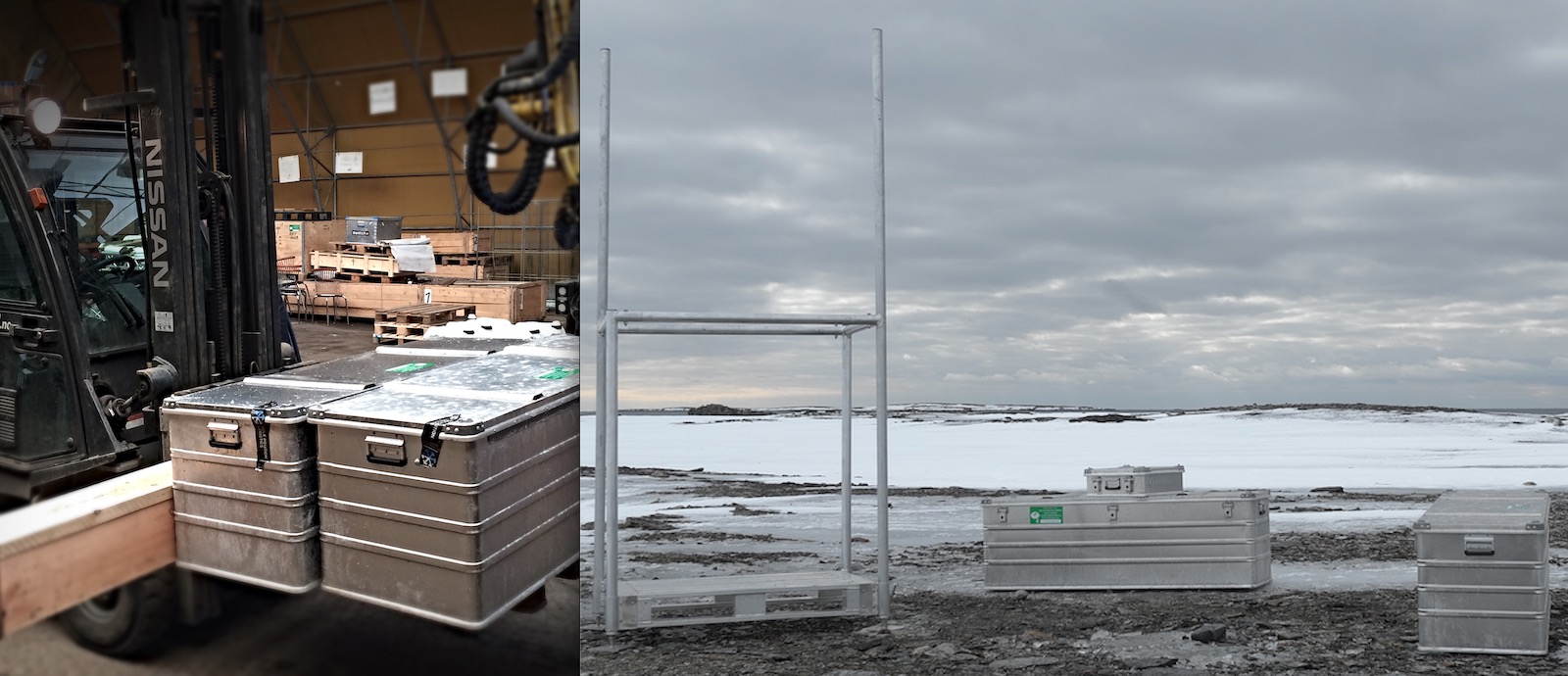
All of the parts, small and large, of the Field Station have been transported from different countries, according to a particular program - as environmentally friendly as possible, packed in special and secure aluminum and wooden boxes. Logistic is important, if something goes wrong, the project may fail! Loading from a local warehouse in Longyearbyen on the way to the expedition ship M/S Origo, so the contents a few days later can be used at the spot of the Field Station. PHOTO: Lars Hansen | Bridge Builder Expeditions Spitsbergen, VOYAGE IV:A, 2019.
In this year’s first expedition (VOYAGE IV:A) the main goal was to install the temporary micro FIELD STATION | NATURAE OBSERVATIO | MARTIN’S EYE on the chosen spot. Documentation and collecting of data will be done via the autonomous Field Station during the summer. A follow-up fieldwork and overhaul schedule for the Field Station will be made in September 2019 (VOYAGE IV:B). The Field Station is named after the first scientist (naturalist) who visited this place in 1758, Anton Rolandsson Martin, one of the so-called Linnaeus Apostles.
The chosen spot
The location of the Field Station - Coordinates: LAT: 78.363333 LON: 11.614458. Altitude: 5.5 m – is positioned at a short distance from the coastline along the west side of the majestic Forlandsletta, on a smaller height circa 5 meters above sea level. This location has unrestricted visibility in all directions giving simultaneously a good overview of the close-by and the distant landscape - an ideal position to observe Forlandsøyane, the coastal and mountainous areas and Forlandsletta in an easterly direction. In-depth studies of this geographical area have taken place since 2016 via fieldwork on the locality, previous research material and historical travel journals. Due to an ongoing dialog with The Governor of Svalbard the project has been granted the opportunity to erect a temporary micro-field station, to carry out entirely automated observations of the local biosphere.
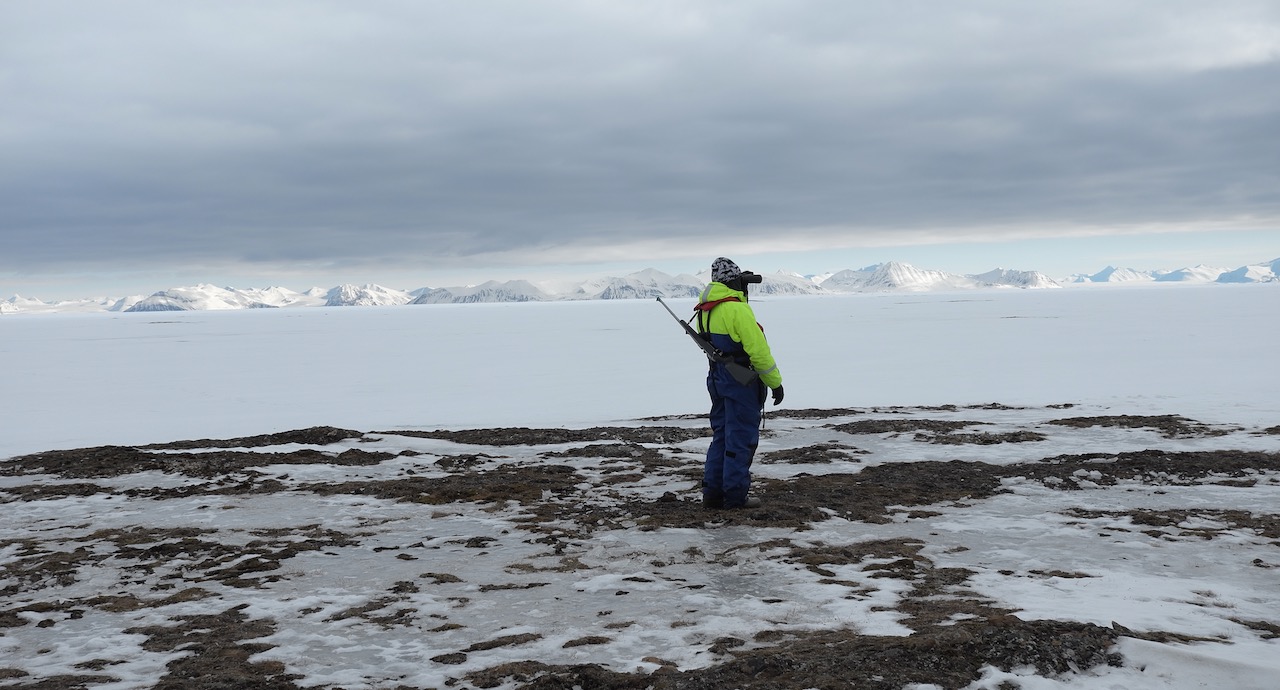
Polar bear guard observing the majestic landscape from the chosen spot for the Field Station | Naturae Observatio | Martin's Eye. PHOTO: Lars Hansen | Bridge Builder Expeditions Spitsbergen, VOYAGE IV:A, 2019.
The Work
During the fieldwork of earlier years, 2016 to 2018, we have some experience of how the forces of Nature can hit this exposed coast! For that reason, we expected harsh weather conditions during the necessary Zodiac ship-to-shore transportation of material and participants between our expedition ship M/S Origo and the west coast of Forlandet. This fear proved to be unnecessary however, with the sea mainly calm and the weather the best possible for the season - cold, sunny, dry and the barometer showed favourable trends. Such good conditions made it possible for M/S Origo, for almost five days and nights to lay at anchor a short distance from the stretch of water between Nordøya and Midtøya - a truly unique and magnificent experience!
The fine weather and 24-hour daylight periods meant that the planned logistics between ship and land could proceed without major obstacles. The two to four meter high ice wall separating the chosen landing spot, a lagoon and sandy beach, and the plain itself together with the tidal water were the only natural elements which caused some extra work.
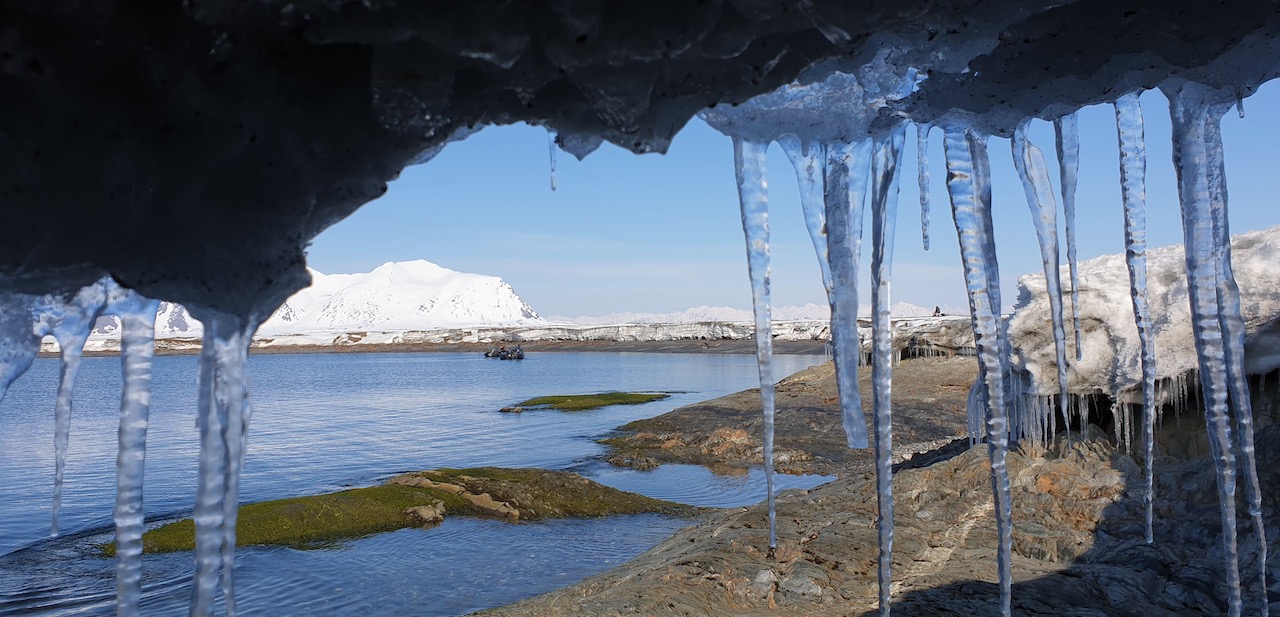
The sandy lagoon with the high ice wall. PHOTO: Jeff Snoxell | Bridge Builder Expeditions Spitsbergen, VOYAGE IV:A, 2019.
The work was divided into teams, including polar bear guards who had a constant watch out in all directions from the chosen spot of the field station, to make it safe for all other participants involved to concentrate on their individual tasks. Here may be mentioned; conveyors, constructors of the station, technicians for installations and persons keeping track of ongoing documentation. Simultaneously as M/S Origo was the platform of the project for all planning, controlling, communication, engineering, food and periods of rest.
The Field Station itself is constructed to be easy to transport, erect and dismantle after the intended period of use. It is designed as a pipe construction with four legs where two aluminium boxes are placed, which include necessary digital equipment and energy production in the form of fuel cells for all instruments of the station. The station covers an area of 80 x 120 cm and the height is 300 cm.
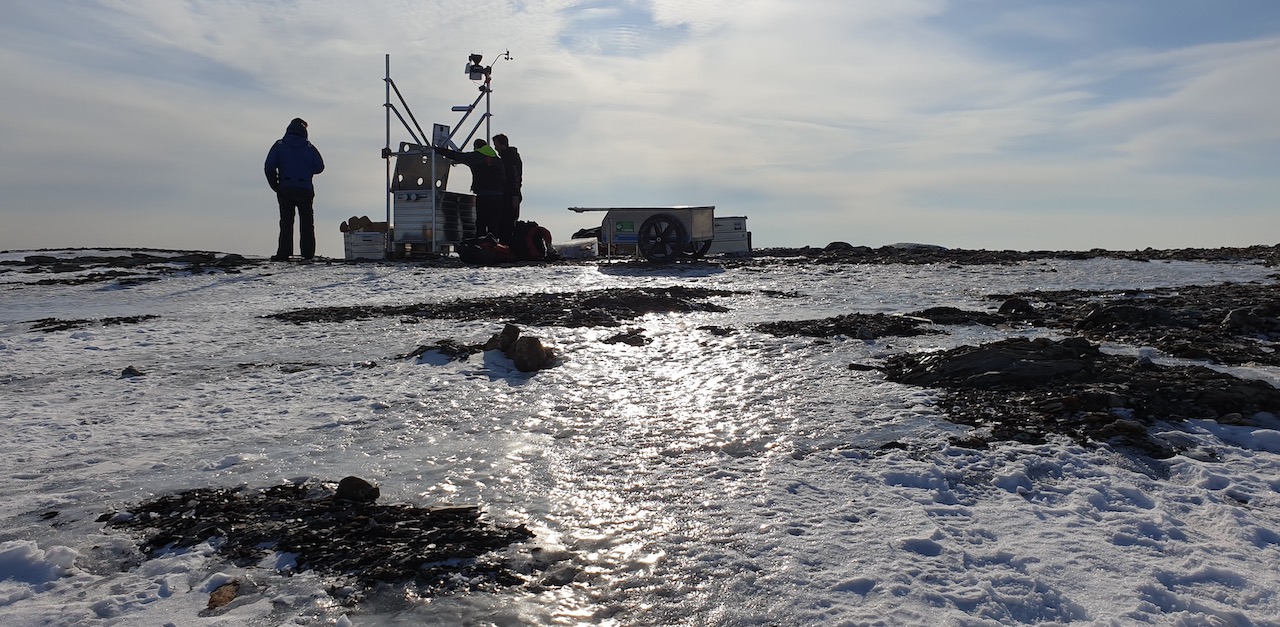
Many skills are needed to erect the field station to provide a high quality structure. PHOTO: Jeff Snoxell | Bridge Builder Expeditions Spitsbergen, VOYAGE IV:A, 2019.
Preliminary results
As from 12 May 2019, the field station makes the following photo documentation via digital photography, all round the clock: Camera 1 in a westerly direction (every 15 minutes): Forlandsøyane and its bird life as well as biosphere, coastline, sea and sky. Camera 2 in a northerly direction (every 60 minutes): the lagoon with sandy beach and its wildlife, biosphere, coastline, sea and sky. Four Trap Cameras aiming to observe the closeup area around the field station. Sound recording, in particular bird calls and song, recorded in 360 degrees every 15 minutes all round the clock. Weather Station measuring; temperature, humidity, atmospheric pressure, rain, solar radiation, evapotranspiration, UV index, wind speed and wind direction.
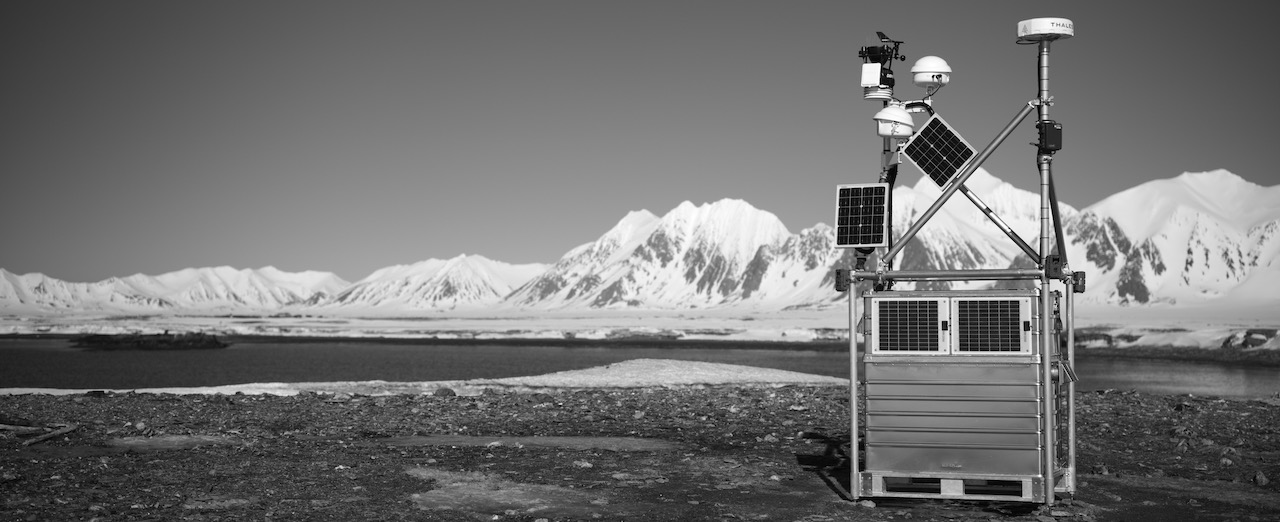
The Field Station | Naturae Observatio | Martin's Eye: from 12 May in 2019 working all round the clock – to make an insight into pure wilderness. PHOTO: Lars Hansen | Bridge Builder Expeditions Spitsbergen, VOYAGE IV:A, 2019.
The weather station sends a report every sixty seconds via its own satellite link (Iridium Next), also serving Camera 2 which on a daily basis sends a picture every afternoon. Additionally all apparatus and instruments store data in internal memories on the station itself. A technical description will be published during the summer of 2019 at the dedicated site Field Station | Naturae Observatio, on this site associated research projects are also described. Research projects from around the world will be linked to the station as well as the results (pictures, sound and data), directly via the Internet being made available under a Creative Commons license.
Lars Hansen
AN AUTOMATED RUGGED SOUND RECORDER ACTIVATED
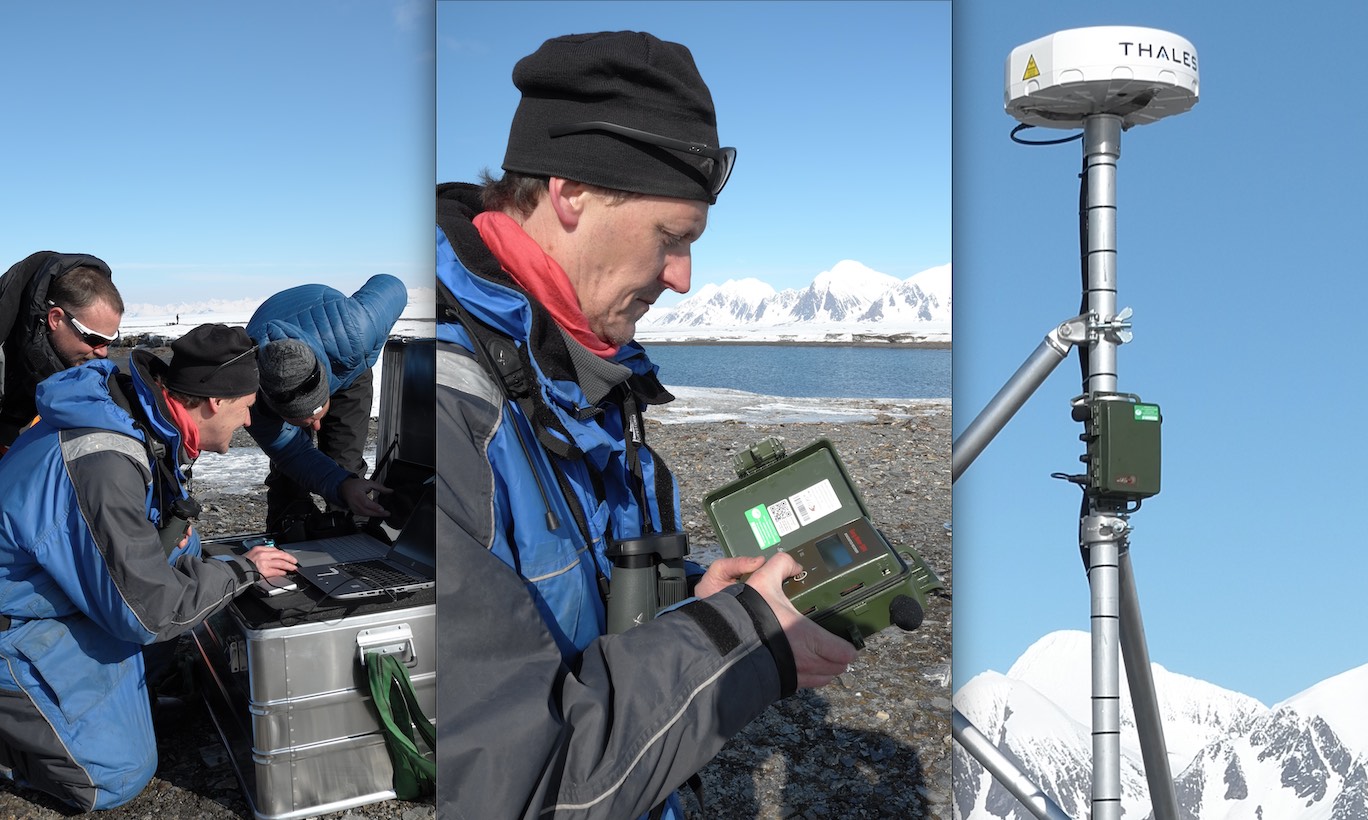
SongMeter is prepared for placement on the Field Station | Naturae Observatio | Martin's Eye - calibration, test mode, activation and then live. PHOTO: Lars Hansen | Bridge Builder Expeditions Spitsbergen, VOYAGE IV:A, 2019.
A SongMeter SM4, an automated rugged sound recorder, with two 128 GB memory cards has been attached to the Field Station in order to record bird songs and other sounds around the Field Station. It has been programmed to make a recording for two minutes every 15 minutes throughout the day. The purpose of the recording is to follow the variation in bird song activity over the day as well as over the season, and together with the still pictures taken from the Field Station, these recordings will be used to identify the species, and ideally provide a minimum number of individuals, present in the research area each day. The recordings will be made publicly available from November 2019 through the dedicate site Field Station | Naturae Observatio. For each day a summary of the observed species as well as (for those species possible) the number of individuals within the research area will be reported through the Global Biodiversity Information Facility (GBIF) portal. GBIF is an international organisation that gather and make biodiversity data available on the Internet.
Ulf Johansson
SURVEY PHOTOGRAPHY AND ARTIST WORK
General
Essential aspects of the expedition were documented both photographically and through artist work. These documentations were concentrated to the Field Station, its erection, its site and its surrounding landscape. Photographs and artist work were made both from the vicinity of the Field Station site and from the sea west of the site. The photographic and artistic survey work was performed in a systematic manner.
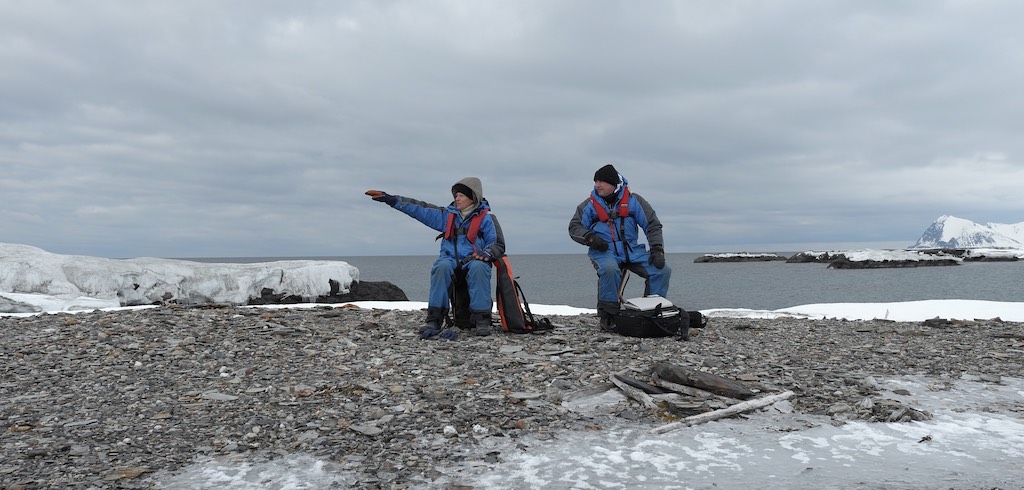 The surveyors located in the center of the area near the Field Station. PHOTO: Lars Hansen | Bridge Builder Expeditions Spitsbergen, VOYAGE IV:A, 2019.
The surveyors located in the center of the area near the Field Station. PHOTO: Lars Hansen | Bridge Builder Expeditions Spitsbergen, VOYAGE IV:A, 2019.In addition, a number of photographs were obtained of the members of the expedition and the M/S Origo crew together. These group documentations were made prior to M/S Origo departure from Longyear harbour on Monday May 06 and when the ship was anchored in the sea west of the Field Station site on Saturday May 11. On May 06, photographs were obtained with the group standing in front of M/S Origo, on May 11 with the group assembled in the bow of the vessel. Further, on Saturday May 11, members of the expedition were photographed in front of the Field Station. Moreover, expedition participants obtained photographs during the expedition, albeit in a spontaneous and ad hoc manner rather than systematically.
Survey work Tuesday May 07
From the beginning of and following the continuation of the work on the erection of the Field Station, the progress of the construction work was documented. Photographic documentation was rather detailed, while corresponding artist work was more occasional.
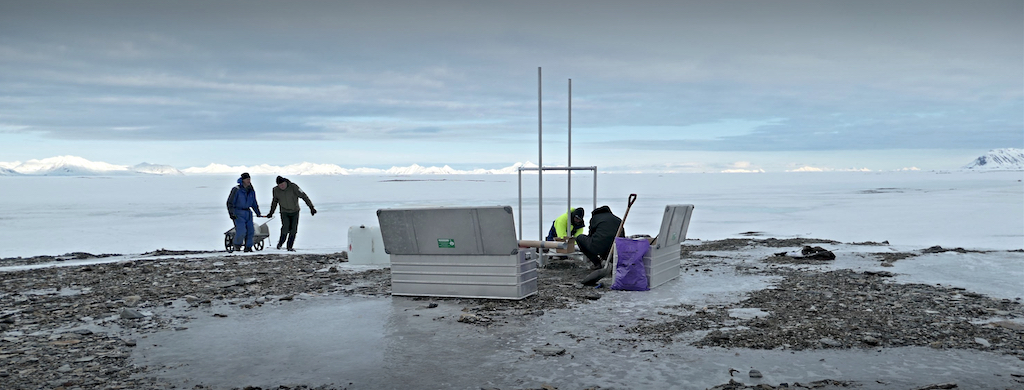 Documentation of the work on the erection of the Field Station. PHOTO: Arne Ardeberg | Bridge Builder Expeditions Spitsbergen, VOYAGE IV:A, 2019.
Documentation of the work on the erection of the Field Station. PHOTO: Arne Ardeberg | Bridge Builder Expeditions Spitsbergen, VOYAGE IV:A, 2019.
In parallel, photographic and artist documentation was performed of the surroundings of the Field Station. The two surveys were geographically coordinated, both systematically covering the entire surrounding landscape and sea throughout the full circle as seen from the site.
Survey work Thursday May 09
During continued construction work at the site of the Field Station, renewed documentation was made photographically as well as through artist work. Photographs were now obtained from a Zodiac. The photographs were all obtained from the sea west of the Field Station site but with varying distance from it. The surroundings of the site were systematically documented. The shoreline was generously covered. The same concerned the surrounding nature.
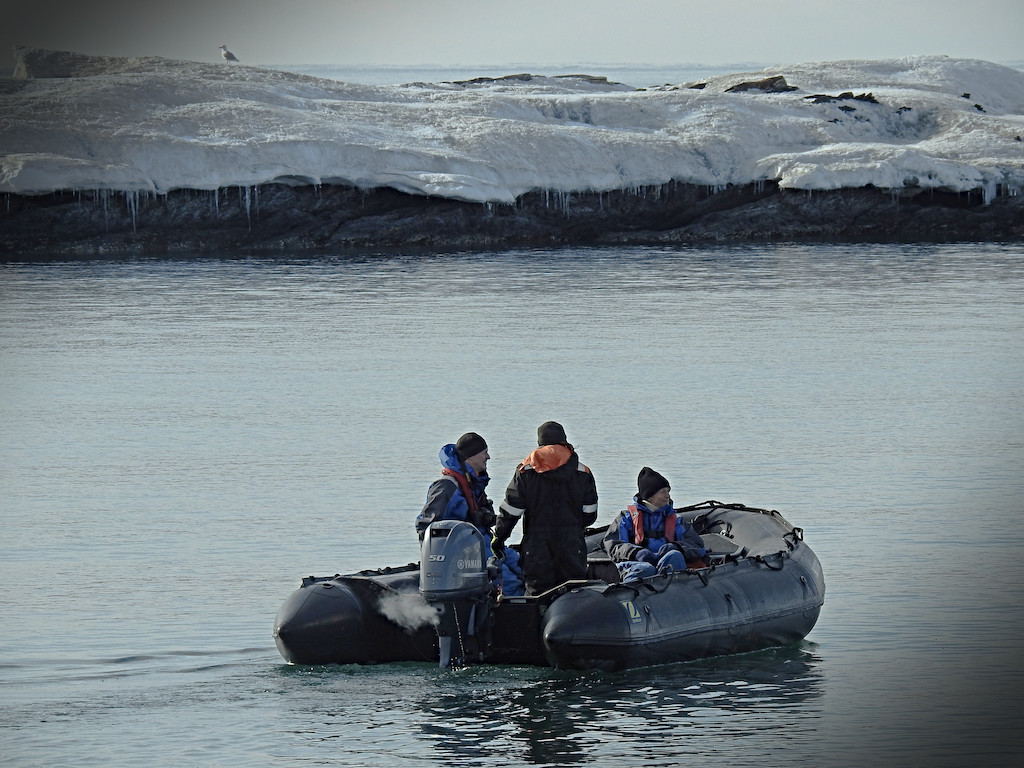 Photographic documentation of the coastal area west of the Field Station. PHOTO: Mikael Sjögren | Bridge Builder Expeditions Spitsbergen, VOYAGE IV:A, 2019.
Photographic documentation of the coastal area west of the Field Station. PHOTO: Mikael Sjögren | Bridge Builder Expeditions Spitsbergen, VOYAGE IV:A, 2019.
In addition, aspects of the Forelandsøya were documented in some detail. In parallel to the photographic documentation made from the Zodiac, artist work was performed. The latter form of documentation was made from M/S Origo.
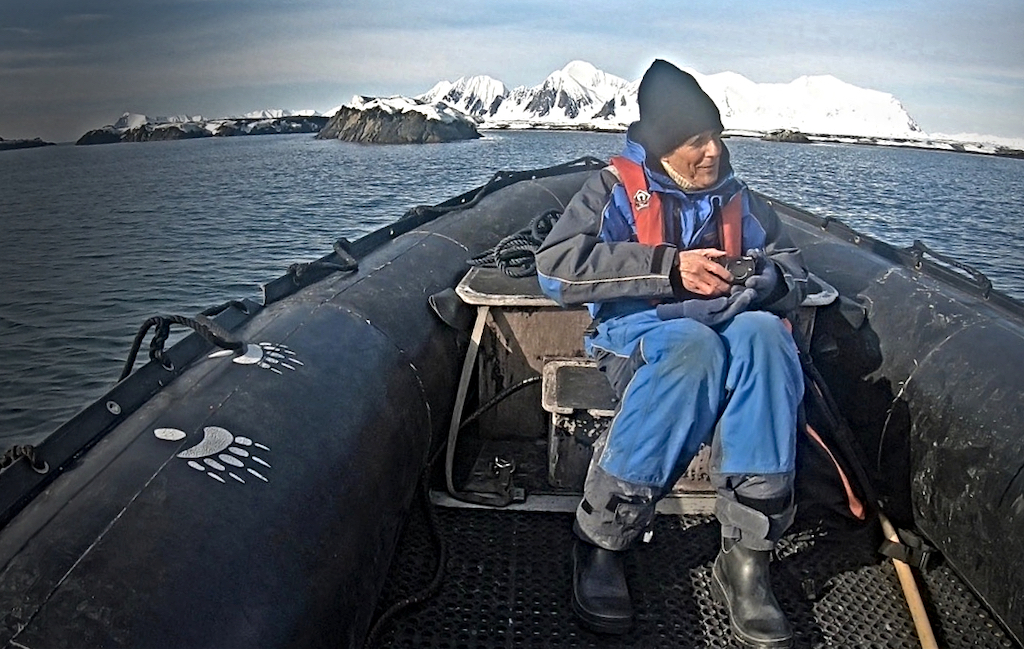 Camera, pencil, paper and patience are the surveyor's main ”tools”. Arne documents the coastal area. PHOTO: Nicklas Svensson | Bridge Builder Expeditions Spitsbergen, VOYAGE IV:A, 2019.
Camera, pencil, paper and patience are the surveyor's main ”tools”. Arne documents the coastal area. PHOTO: Nicklas Svensson | Bridge Builder Expeditions Spitsbergen, VOYAGE IV:A, 2019.
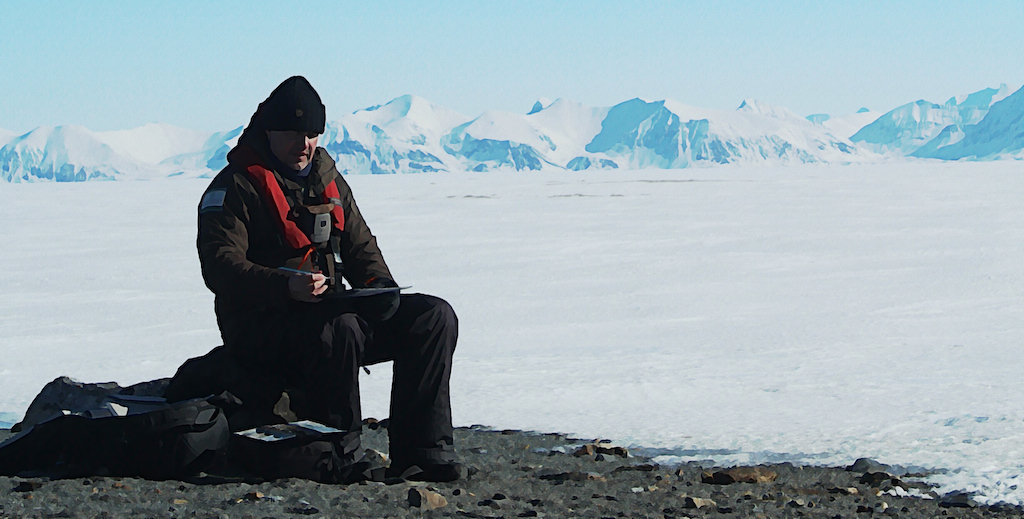 The expedition's field artist Måns tries to capture the landscape's biosphere around the Field Station. PHOTO turned into a digitally created watercolour: Henry Mills | Bridge Builder Expeditions Spitsbergen, VOYAGE IV:A, 2019.
The expedition's field artist Måns tries to capture the landscape's biosphere around the Field Station. PHOTO turned into a digitally created watercolour: Henry Mills | Bridge Builder Expeditions Spitsbergen, VOYAGE IV:A, 2019.
Survey work Friday May 10
Following the completion of the Field Station, including its full set of instruments and other installations, documentation of the station took place. As before, this documentation included both photography and artist work. A number of aspects of the complete Field Station were photographed and pictured. Further, drawings of the Field Station were performed as seen from a Zodiac.
Inspection of documentation
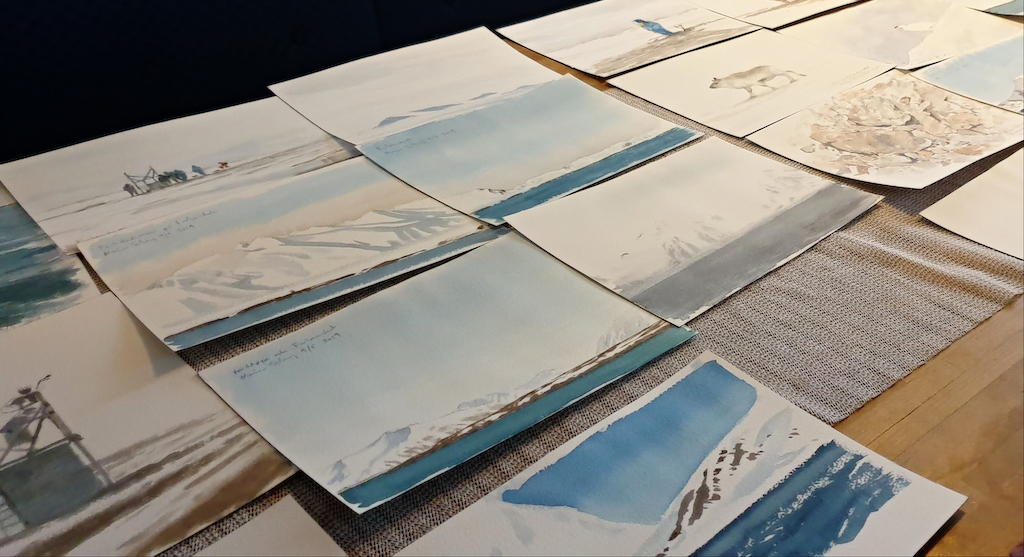 Table vernissage onboard the expedition ship. PHOTO: Jeff Snoxell | Bridge Builder Expeditions Spitsbergen, VOYAGE IV:A, 2019.
Table vernissage onboard the expedition ship. PHOTO: Jeff Snoxell | Bridge Builder Expeditions Spitsbergen, VOYAGE IV:A, 2019.
At the end of the expedition, the systematically obtained documentation material was inspected. All photographs were copied and saved. When saved, they were inspected and ordered. The artist work was the subject of an informal vernissage in the evening of Sunday May 12. All of the documentary material is saved and ordered for later reference.
Arne Ardeberg and Måns Bergendal
THE FIELD ARTIST'S THOUGHTS
Visibility remained excellent throughout most of the week and facilitated work. So did the wind, which was approximately 1-4 metres per second during our whole stay in the vicinity of Prins Karls Forland. Temperatures were constantly below zero favouring first impressions and simplicity.
Wildlife painting started prior to the departure of M/S Origo on May 6th. Landscapes and coast profiles were documented with both pencil drawings and watercolours and for the most part produced from the afterdeck, while people at work were depicted at the site of the Field Station. The avian and mammal fauna, as well as some slates on the location of the station, were rendered in watercolour. Artist work also covered the construction of the Field Station at different stages.
A sector survey of the surrounding landscape was carried out a few meters west of the Field Station on May 7th. Photographies and pencil drawings were made simultaneously and with a common view on the sectors’ boundaries. On May 9th, a camera was used for a similar study from an inflatable boat positioned in Levinhamna approximately 150 meters west of the field station, and at another point about 100 meters north of Nordøya. At the same time, Prins Karls Forland and Forlandsøyane, in particular the site of the Field Station, were documented through artist work from M/S Origo. The day after, the photographic surveys from Levinhamna were followed by line drawings made from the same positions.
Field artist Måns Bergendal | PHOTO: The IK Foundation/Estvall | Bridge Builder Expeditions Spitsbergen, Voyage IV | Click here for more Pictures
Methods and materials were further reassessed. Following the experiences from previous Bridge Builder Expeditions, the paintbox included a clasp knife and travel brush, both with a positive result since they fitted in the box and were just right for their respective purposes. Furthermore, thin woolen gloves proved a good protection without reducing dexterity too much. Sea water proved a useful asset at temperatures below zero since it lowers the freezing point and thus prevents ice crystals from forming on the paper and mixing area and allows glazing.
On May 12th, at the very end of the expedition, a simplified art show was held on a dinner table in the mess hall. Plans were also made for field artistry on future expeditions. Graphite pencils will then be used since those are soft and thick and are expected to be usable in cold conditions that inhibit finger motion.
Måns Bergendal
THE PARTICIPANTS
EXPEDITION PARTICIPANTS
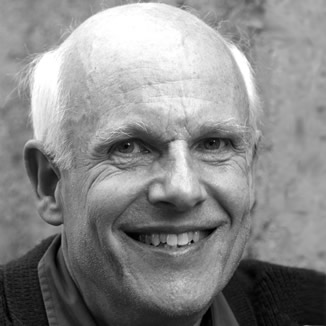
Arne Ardeberg
- (b.) 1940
- DUTY: Participant, researcher.
- AIM: Monitoring of Aurora Developments. Studies of Noctilucent Clouds. Recording of Meteors. Coordination of Science Projects and Technical Installations.
- POST: Professor emeritus in Astrophysics, Lund University, Sweden. Member of Royal Swedish Academy of Sciences, Royal Physiographic Society, Royal Society of Sciences, Chair of Crafoord Prize Committee in Astronomy and LMK-stiftelsen, Foundation for Interdisciplinary Scientific Research.
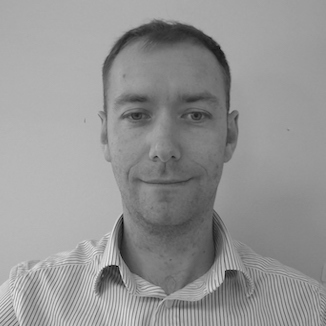
Tom Chicken
- (b.) 1983
- DUTY: Participant. Install and Commission fuel cell power system.
- AIM: To establish a reliable power supply for the Field Station.
- POST: Field Assistant/Technician (CTO).
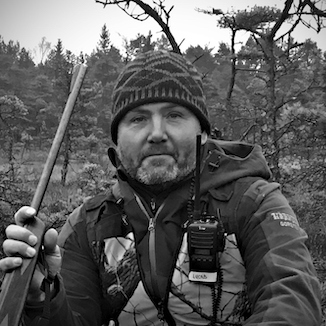
Andreas Eriksson
- (b.) 1972
- DUTY: Participant, field assistant.
- AIM: The aim is to assist the other participants via my interest in Nature and knowledge of hunting, to create a safe working environment for this expedition to Spitsbergen/Svalbard.
- POST: Company owner: building fireplaces and tiled stoves.
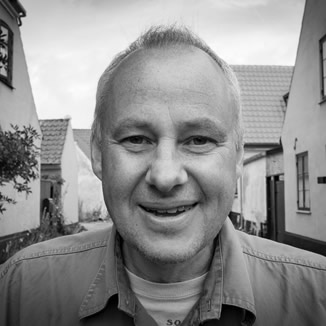
Lars Hansen
- (b.) 1960
- DUTY: Expedition leader, researcher.
- AIM: To strengthen our insight of the fieldwork that the so-called Linnaeus Apostles started almost three centuries ago. To understand Natural and Cultural History of Planet Earth – and hopefully building "new bridges of proficiency" between the past, present and future!
- POST: Head at The IK Foundation, FRGS, London, United Kingdom.
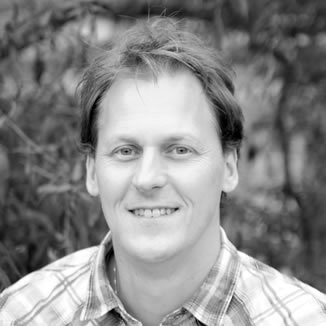
Ulf Johansson
- (b.) 1970
- DUTY: Participant, researcher.
- AIM: (A) To carry out an inventory of bird nests on Forlandsøyane to be compared with a corresponding area on Forlandet. (B) Continue to collect information and document the travels of the earliest scientific explorers to Svalbard (1596-1799).
- POST: Curator of birds, Swedish Museum of Natural History.
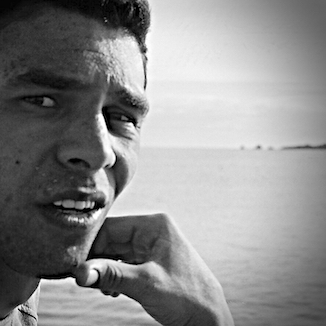
Henry Mills
- (b.) 1991
- DUTY: Participant. Assisting with the fuel cell power supply design and installation.
- AIM: To provide reliable power to the Field Station equipment. The application requires that the power supply endures the harsh climates and provides the autonomy required over hundreds of days without maintenance.
- POST: Field Assistant/Technician.
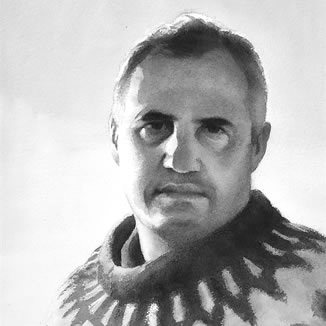
Måns Bergendal
- (b.) 1964
- DUTY: Participant, field artist.
- AIM: I want to convey what I see with immediacy and simplicity to make the viewer feel present on the Arctic scene. Watercolor is the most portable medium and an excellent one for this purpose.
- POST: Watercolour artist, illustrator and instructor, Röstånga, Sweden.
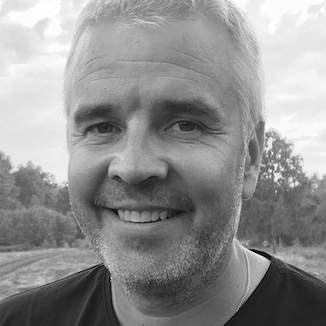
Mikael Sjögren
- (b.) 1970
- DUTY: Participant, field assistant.
- AIM: To assist the other members and to achieve a secure working environment. It will also be a great experience to visit Spitsbergen and see the nature and wildlife.
- POST: Project Manager / New development at CWP. Forest owner Hyltan Estate Sweden.
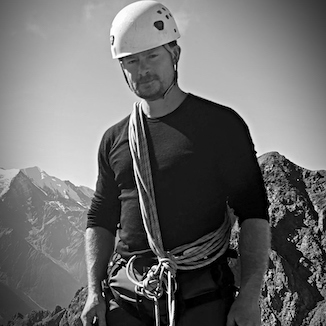
Jeff Snoxell
- (b.) 1971
- DUTY: Participant, technical expert, webmaster.
- AIM: Ensure the Field Station components are correctly configured, connected and fully operational. Very interested in gaining more knowledge about one of our last wild places on planet Earth.
- POST: Hardware and software specialist.
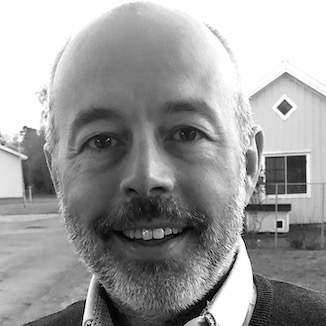
Peter Sten
- (b.) 1971
- DUTY: Participant, field assistant.
- AIM: My aim is to assist the other participants and create a secure working platform. It is a great opportunity to be able to follow an expedition to Spitsbergen/Svalbard.
- POST: Focus on hunting and fishing on the family forest estate. Adviser and numismatist.
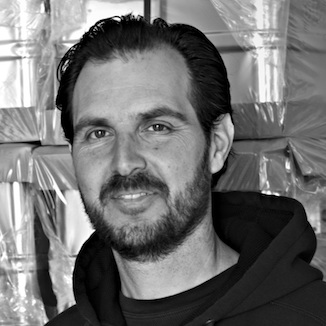
Søren Wiberg
- (b.) 1972
- DUTY: Participant. Field assistant/Technician
- AIM: My essential contribution to the expedition is to design and build the field station, but also serve for safety and assistance to the other members. By taking part in the expedition to Svalbard, my hope is to get a better understanding for the human impact on these remote areas, and to be a part of the history of the Linnaeus Apostles’ fieldwork.
- POST: Forestry and Landscape engineer, founder and owner of the family company AluBox.
EXPEDITION SHIP CREW
- Master, Olle Ljungholm
- Chief Officer, Gustav Löwing
- AB, Nicklas Svensson
- OS, Mathias Wallén
- Chief Engineer, Daniel Persson
- Chef, Christian Cederberg
- Stewardess, Hanna Dahl
- Steward, Lisa Björk
EXPEDITION BACK BASE
- Art & Digital work: Graham Scott
- Research: Viveka Hansen
- Controller: Jennie Asher
- Maritime lawyer: Bo Benell
- The Reception Desk: Leo Ryder
EXPEDITION PATRONS
- LMK-stiftelsen, Foundation for Interdisciplinary Scientific Research
- The IK Foundation
iPROJECTS
iPROJECTS
In The IK Foundation and The IK Workshop Society there are continually ongoing comprehensive projects, each having different character and format. In iPROJECTS the current works and ideas are presented - Expeditions, Fieldwork, Research, Presentation in progress, and much more... For regular updates, and to make full use of iLINNAEUS' possibilities, we recommend fellowship by subscribing to our monthly newsletter iMESSENGER.
NAME OF PROJECT
- (Main title) The Linnaeus Apostles BRIDGE BUILDER EXPEDITIONS To Understand Planet Earth
- (Subtitle) BRIDGE BUILDER EXPEDITIONS - Spitsbergen (Svalbard)
- FIELD STATION | NATURAE OBSERVATIO | MARTIN’S EYE
GEOGRAPHICAL SCOPE
- Spitsbergen, Svalbard; in the agreement of the international Spitsbergen treaty (Svalbard treaty)
SUBJECTS
- Geography
- 18th century Studies'
- Cultural History
- History of Science
- Natural History
- Economic History
- Field Notes, Arts and Photography
- Field station, long-term observations
- Ecology
INSTITUTIONAL RESOURCES
- The IK Foundation, London, United Kingdom
- Natural History Museum University of Stockholm, Sweden
- Grenna Museum Polarcenter, Sweden
- University of Gothenburg, Sweden
- The Norwegian Meteorological Institute, Norway
- Lund university, Sweden
- The Royal Geographical Society (with IBG), United Kingdom
- The Swedish Academy, Sweden
- Stockholm university, Sweden
- University of Tromsø, Norway
- INTERACT | International Network for Terrestrial Research and Monitoring in the Arctic, EU
- GBIF | Global Biodiversity Information Facility, Norway & United Kingdom
- Natural History Museum University of Oslo, Norway
- Department of Biology, Lund University, Sweden
- Lund Observatory, Department of Astronomy and Theoretical Physics, Lund University, Sweden
- UNIS Aurora Observatory: The Kjell Henriksen Observatory (KHO), Svalbard.
PATRONAGE
This site/project
has been made globally available in collaboration with:
 Feel welcome to read more about how to take part...
Feel welcome to read more about how to take part...
 Feel welcome to read more about how to take part...
Feel welcome to read more about how to take part...
TIMELINE
- 2016: Expedition Voyage I: Field work, research, documentation and follow-up work.
- 2017: Expedition Voyage II: Field work, research, documentation and follow-up work.
- 2018: Expedition Voyage III: Field work, research, documentation and follow-up work.
- 2019: Expedition Voyage IV:A (May) and Voyage IV:B (September/October): Field work, research, documentation and follow-up work.
- 2020: Expedition Voyage V: Dismantling of the Field Station, documentation and follow-up / planning of publicise work.
- 2021: Research, follow-up work, Publicise work of Publication | Exhibition | Multimedia, with the title NATURAE OBSERVATIO SPITSBERGEN | SCIENCE EXPEDITIONS | TEXTS & OBSERVATIONS FROM THE PAST TO PRESENT TIME.
- 2023/24: International launch of the publicise work of Publication | Exhibition | Multimedia, with the title NATURAE OBSERVATIO SPITSBERGEN | SCIENCE EXPEDITIONS | TEXTS & OBSERVATIONS FROM THE PAST TO PRESENT TIME.
PUBLICISE
- iLINNAEUS.org
- Publicise work of Publication | Exhibition | Multimedia, with the title NATURAE OBSERVATIO SPITSBERGEN | SCIENCE EXPEDITIONS | TEXTS & OBSERVATIONS FROM THE PAST TO PRESENT TIME.
- Field Station | Naturae Observatio
- Expedition Picture Portfolio
- Expedition Video Portfolio
- Expedition Panoramic Portfolio
LINKS | FURTHER READING
- Research in Svalbard (RIS)
- RIS-ID 10275 (Bridge Builder Expeditions Spitsbergen)
- RIS-ID 11055 (Field Station Research Projects)
- The Norwegian Polar Institute's topographical Svalbard map portal
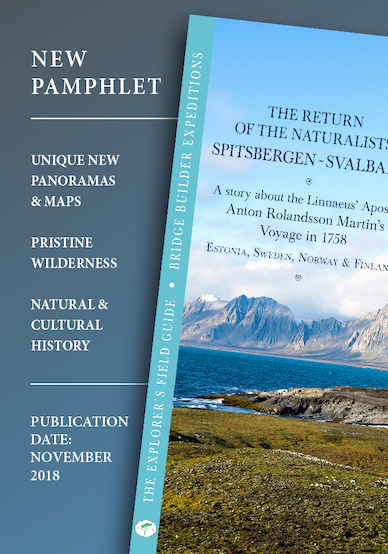
Updated/Checked 27/09/2023
THE IK FOUNDATION & COMPANY PROMOTING NATURAL & CULTURAL HISTORY
SUBSCRIBE TO OUR NEWSLETTER
TRANSLATE PAGE
A link to this page has
been copied to your clipboard
SHARE @been copied to your clipboard




© The IK Foundation & Company 2025
– a truly European organisation since 1988
– a truly European organisation since 1988
Legal issues | Forget me | and much more...
How to cite & Creative Commons
You are welcome to use the information and knowledge from
The IK Workshop Society, as long as you follow a few simple rules.
LEARN MORE & I AGREE
You are welcome to use the information and knowledge from
The IK Workshop Society, as long as you follow a few simple rules.
LEARN MORE & I AGREE











